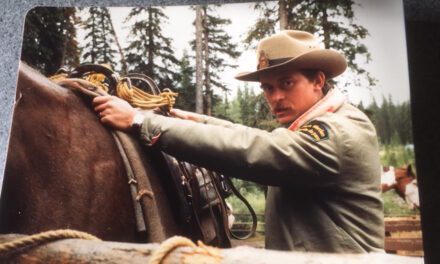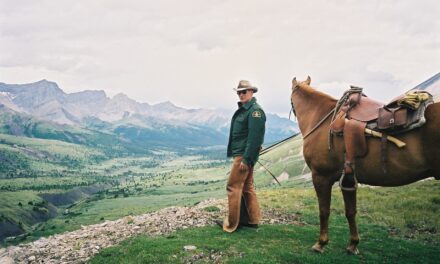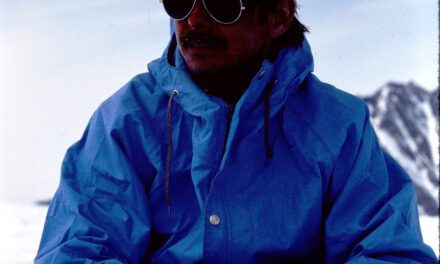Park Warden Alumni Society of Alberta
Oral History Phase 11 Fall 2021
This Oral History interview was funded in part by a research grant received in 2021 from the Government of Alberta through the Alberta Historical Resources Foundation.
In Person Interview with Doug Eastcott
Date/time: September 20, 2021
Interviewed by Monique Hunkeler

Place and date of birth? Calgary in 1948
MH: Where did you grow up?
DE: I grew up in Calgary. We made occasional forays as a family into the mountains. I knew a little bit about Banff Lake Louise, Yoho, Kootenay, Jasper.
MH: How did you become involved in the Warden Service? Which national park did you start working in?
DE: I was a Park Naturalist in 1970, along with a Bruce McKinnon, who became a Warden but was a naturalist with me. And also I went to University with Brian McDonald, who was prominent in the Warden Service for quite a while. Shortly after that, they decided to go in the Warden Service, and I decided to become a teacher. I kept in touch with Bruce because we climbed together quite a bit, and it became obvious who was having the most fun. So I decided to apply for the Warden Service, I applied for 1974. But they didn’t give me quite enough time to resign the teaching job and walk away. So they offered again in 1975 and I had enough time so I joined in 1975. Went to Jasper and it is my first Park.
MH: What made you want to join the Warden Service? 0146:
DE: I think just seeing what a cool job it was, the variety and the things that the guys did. Bruce and Brian weren’t the only Wardens I’d had interactions with. I knew Larry Gilmar and Jim Rimmer and a few others. So I knew a little bit about the kinds of things they did and it seemed very cool. And I always liked National Parks and wanted to kind of get involved with them.
MH: What different parks did you work in? How did they compare? Do you have a favourite?
DE: I worked in quite a few. I started in Jasper went to Elk Island, then Nahanni and then Banff. Plus I worked in the Regional Office for a bit in there too.
MH: What were some of your main responsibilities over the years?
DE: I’ll go through them a Park at a time and just talk about them that way.
0241: I started in Jasper in 1975 and was seasonal there for six years (left there in the spring of 1981). Three of those years my position was half year and then Don Dumpleton really looked after the seasonals quite a bit and he created a bunch of 10 month positions, and I was lucky enough to get one of those for three years, so that made it pretty cool.
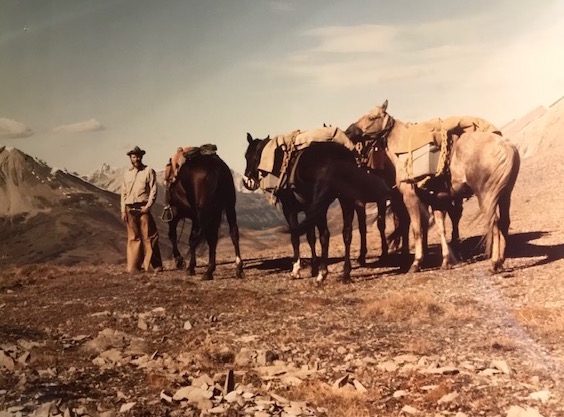
Doug and horses North Boundary Jasper National Park1980
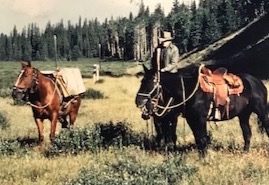
Meadows at Willow Creek Summer 1977 Jasper Frank Burstrom
In Jasper, I had three backcountry districts over those six years which is hard to believe. But I started with Blue Creek district. And then the next year I had the Willow Creek district. And then my last year, I put in a special request for a backcountry district and got the Smokey district. So that’s the three on the north boundary. And we were out there for roughly five and a half months each summer. Yeah, and we worked 24 and four so really long shifts because they’re remote districts and they’re really big districts. So that was awesome. When I went there, I didn’t know anything about horses to speak of. I’d ridden one a couple of times that was it. Brian Wallace was the backcountry supervisor and he turned into quite a mentor for me in terms of working in the backcountry, working with horses, and not to mention working with people because Brian is amazing with people as well. So anyway, that was pretty special. And then the other thing we did up on the north boundary is we did a lot of camping trips, because there’s quite a few areas up there where there aren’t any cabins or anything. So we’d load up the horses with tents and camping gear and just go off into the middle of nowhere to places like Idalene Lakes and the South Fork of the Snake Indian and also over Moose Pass and Colonel Pass. So kind of starting in the Smoky District and working your way south along the Great Divide and come out at the Decoigne Warden station which is on the great divide, on highway 16. And from Blue Creek we went up into the Willmore wilderness especially during boundary season to see what kind of hunting activity was going on out there. The backcountry work involved being self-reliant and close to nature and working alone for long periods of time with horses in the sort of place where things could go wrong if you’re not careful. So learning to be safe.
0531: Also in Jasper, I worked in the town Law Enforcement for one summer and then worked at Sunwapta Warden Station for another summer and then one winter up at Marmot Basin doing avalanche control. And one thing that comes to mind, especially in the town area, was that was the time before Parks Canada really refined its garbage handling procedures and so there was a lot of bear issues and lots of black bears and then one notable grizzly bear started hanging around the Whistler campground and we nicknamed it “paws”. And every night it would come to these giant dumpsters and tip them over and go through them, and everybody was nervous that somebody was going to get hurt in the campground having a garbage grizzly running around. I think management was sort of playing a game of chicken with each other about developing a garbage handling system and the fact that it was going to cost a lot of money and some managers didn’t want to spend the money and other managers thought “well we’re just gonna let this bear push the limits a little bit here until senior managers get a little more nervous”. Anyway the end result of that was the garbage handling became really secure and the dump got fenced with electric fences. There was a dump in Jasper in those days so bears would go to the dump. One time we were on a climbing school with Willi Pfisterer at some cliffs that were above the dump and we were up there climbing on these cliffs and we look down at three grizzly bears wandering across the meadow heading for the dump. It was totally amazing but scary in a way that the bears were relying on their food to come from the dump.
0805: Other things that happened in Jasper was the Brazeau Bandit. Dave Cornell was the warden who got held up by this “bandit” and right away after we went in the helicopter, so I got taken along because I was a Town Warden then. We flew all over the place looking for this guy, but never saw any sign of him. But I remember we landed at each cabin, and we all had rifles and we had to kind of sneak up to the cabin to see if the guy was there. I don’t know why we thought the guy would be hanging out at a warden cabin. But anyway, we did, but we never saw any trace of him at all. And then we went in with some horses a few days later, but weren’t able to track him either. So that was the end of my involvement with that incident but I think they did recover the saddles and stuff later. It was kind of like Keystone cops in a way, we just weren’t prepared for anything like that.
0925: The summer I was at Sunwapta (Mile 45), it was kind of an eye opener because I’d done a fair bit of climbing before I joined the Warden Service, but not that much after. I’d gone to a few schools and that was it. But a lot of people died during that summer. And the first incident that I was involved in, we were just sitting at the house in the evening and we got word there had been a big accident up Sunwapta hill and we went up and it was three young guys had run off the road in their truck and rolled it. They were all dead, of course, but they were in the process of dying when we got there but by the time we got into town they were dead. So that was quite a shocker. And then a couple of weeks later there was another car accident that I didn’t go to but Murray Hindle went to, and again, same corner and somebody had crashed into another car and the person had died. And then one day I came back from days off and I was riding back to the station with Darro Stinson and he said, “Well, there was a big rescue on Mount Edith Cavell this weekend and some guys from Calgary died”. And I said, “Oh, who is that”? And he said, “Eckhart Grassman”. And Eckhart was a guy I knew from Calgary that I used to climb with and ski with. It was just a total shocker for me to know that somebody I knew had been killed there. That was kind of some of the highlights of that summer.
1056: At that time, Don Dumpleton was really keen on improving the warden cabins in the backcountry. And so some of the cabins he had them lifted up and new rounds of logs put around underneath if they were rotting out. But the old cabin at Willow Creek, which was actually built by Frank Burstrom’s grandfather in about 1906 or 1908, was quite historic, but it had a lot of earth banked up against it and the logs were really rotten. It was determined that it couldn’t be saved. The Warden Service had bought a new panabode cabin, and it had been trucked to the end of the Snake Indian road so during the winter, Frank and I freighted it in with skidoos to Willow Creek. And so then the summer I was at Blue Creek, Tom McCready was there with the cabin crew and they built the new cabin. But we didn’t move in, we kept using the old cabin. The next summer when I was at Willow Creek as the District Warden, Don Dumpleton came up and said, “Okay, we’re going to move into the new cabin”. So he and I moved all the stuff over into the new cabin and the old cabin was kind of closed up and not used. And then we stored a bunch of hay in it.
And then, I think it was in the winter of 1980, John Strachan and I were going out on a patrol with the skidoos and just as we were leaving the office, Abe Loewen, one of the managers said, “Oh and burn the old cabin down while you’re up there”, and we’re just kind of like, that’s the first we’ve heard of it, and we thought well, he’s kidding. He surely doesn’t mean it. So we went up there and did our our patrol and our work and came back and as soon as we got to the office, Don Dumpleton cornered us right away. “Did you burn the cabin?” And we’re like, “No, you didn’t really mean it did you?” Oh, they were so upset. It was unbelievable. So anyway, they really laid down the law to us. They said, “if you guys want to keep your jobs you’re gonna go back there tomorrow and burn that cabin down.” So we went back the next day and we took a big bottle of rum and built a big fire and I do have a slide here actually of the cabin on fire. We lit it around dinnertime and it burned all night and into the next day, it was a big deal. It was very sad to see it go. But anyway, we toasted it appropriately.
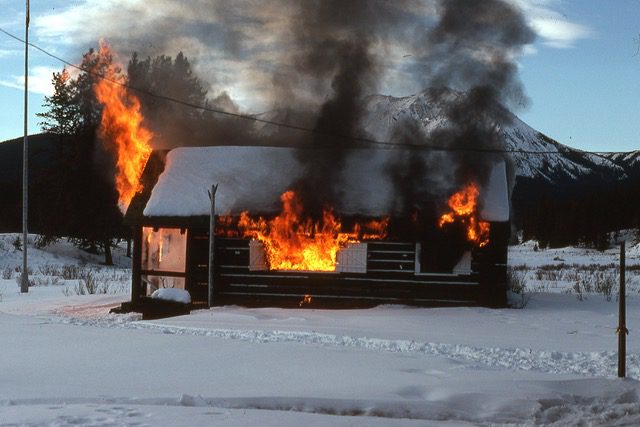
Burning of the old cabin at Willow Creek, Jasper NP, 1980

Doug and Betty Beswick Rescue preparations 1976
1355 In terms of some of the Wardens who inspired me, I mentioned Brian, but also Willi Pfisterer was a pretty key guy up there. And I really liked him. I really felt like I connected with him. And so there’s lots of schools that we went on with him and even little training things because he was based in Jasper. He could just pop over the Warden Office and say, “Hey, you got a couple of guys with a bit of time let’s go do something”. But I remember going on the 8 Pass route with him. That was pretty cool, and the other big one was we went and climbed Mount Clemmenceau as a Warden School and that was a big deal. A lot of wardens came from quite a few places. We had a big group up there and we had beautiful day and it’s quite a corniced knife-edge ridge that goes on for quite a ways. So that was pretty exciting to be up on top of the world with the whole group. And then did quite a bit of skiing and sledding up on the North Boundary into Tonquin and places like that as well. So that’s kind of the Jasper thing. It was definitely one of those kind of jobs where you had to sometimes pinch yourself. Am I really alive or am I just dreaming this?
